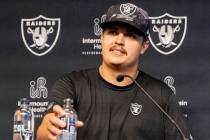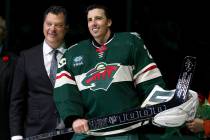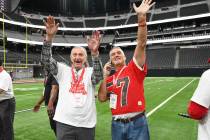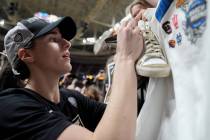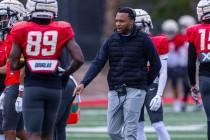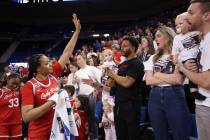Bracket session debunks myths
Two facts about participating in an NCAA Tournament mock bracket session:
It’s a bad time to have given up sweets for Lent when the famous late-night ice cream is served.
Everything we think we know about seeding and bracketing the world’s most famous basketball tournament, we don’t.
This was the condensed version. The appetizer. The 15-hour edition of something that takes the actual selection committee five days to complete.
This was NCAA bracketing on speed and chocolate sauce.
But as a member of selected media invited by the NCAA to attend the annual mock session at the organization’s headquarters last week, I found the process fascinating and informative.
Which, in terms of the latter, means I won’t glance at this year’s bracket come Selection Sunday and wonder if Oliver Stone sneaked into the room and conspired to match midmajor programs against one another or how UNLV finds itself preparing to meet Lon Kruger and Oklahoma.
“I think because the tournament has become such a big deal nationally and the media has grown to where there is so much coverage about the game, the more we can invite people into the process and get them to understand it better, the better off we are,” selection committee chairman Mike Bobinski said. “There has been an effort for several years now to sort of open the trapdoor and allow people to look inside. This (mock) exercise shows the process, and as the word is spread, people will more and more understand we’re not cooking the bracket in any way, shape or form.”
A main reason why: There isn’t time.
In a perfect year, and there aren’t many, bracketing the field would begin at noon Sunday. In the real world, it begins at 1:30. In a stressful year, it could begin at 3.
The field is announced on national television just after 6.
So many potential red flags are raised on a projection screen — are the top three teams from a league separated, has balance been achieved at the top four lines, have regular-season matchups been avoided, what is the fairest fit for teams geographically, have teams that played each other in the two previous tournaments been separated, and on and on — that it’s illogical to believe committee members are conspiring when under such a strict deadline.
I saw it firsthand. We weren’t minutes into bracketing the field when one of those red flags was raised regarding a logjam of Big Ten teams in the same region. We needed 10 to 15 minutes to solve one problem, to drop a 10 seed to an 11 and elevate an 11 to a 10 and move another team from East to South and double- and triple-check that all the shifting fell in line with previous decisions and those which came next.
I walked into the room Thursday afternoon convinced the committee played favorites, wanted as many midmajors eliminated before the tournament’s second week and conspired to create interesting early storylines for television.
I walked out of it Friday believing there wasn’t near the amount of time to make any of that plausible.
Some other observations over the 15 hours:
■ ■ ■
Conference affiliation. This might spell bad news a month from now for a Mountain West ranked anywhere between 1 to 3 this season in conference Ratings Percentage Index, but not once was a team’s league affiliation mentioned. Not once did anyone ask how many teams from this conference or that one were among our 37 at-large selections. Not once did any evidence surface that committee members are insistent a specific number of teams from certain leagues make the field.
There was one year when the committee had six contingency brackets from which to choose, based on what happened in conference tournaments.
It gets that detailed.
New Mexico was the only MW team immediately selected by our committee as an at-large team based on receiving at least eight of 10 votes on the first ballot. As voting continued, Colorado State made it next and was followed by San Diego State and UNLV.
The NCAA staff eventually placed the Rebels as the No. 38 overall seed, later tabbed a No. 10 in the South Region.
Yes, people know about their road issues. It’s not a secret nationally.
■ ■ ■
RPI. Nonconference strength of schedule. Road victories. Record over a team’s last 10 games. Record against common opponents. Head-to-head results. Some of them are guidelines used to select at-large teams, and some aren’t. It depends on the individual casting a ballot.
These are human beings making decisions. This isn’t a Bowl Championship Series computer spouting out numbers. What is important to one person might not be to another when it comes to clicking a mouse over a specific team’s name on a screen.
“Our No. 1 job is to get the best and most deserving 37 at-large teams,” Bobinski said. “If we don’t get that right, the rest of it doesn’t really matter. That has to happen.”
■ ■ ■
It’s tough to make that happen.
I know why coaches favor expanding the field even more, perhaps to as many as 96 teams. Earning a berth almost always means keeping a job and receiving contract bonuses. But if you had seen the poor resumes of nine or so teams we considered for the final two at-large spots, you would realize that in most years, there isn’t near the depth of quality across college basketball. This year is no different. Countless teams are dead-flat average.
Sixty-eight is not only a good number but a necessary one given the lack of deserving teams most seasons.
That said, Virginia Commonwealth was one of the final teams chosen in 2011 and made the Final Four. History such as this is why committee members stress and fret over those final few spots as much as anything during the entire process.
“In many ways, the bracket takes care of itself,” Bobinski said. “The more people can appreciate that, the healthier and better we feel about the tournament and the better it is for the game.”
I walked in looking for Oliver Stone.
I walked out pretty confident he isn’t an annual guest.
Las Vegas Review-Journal sports columnist Ed Graney can be reached at egraney@reviewjournal.com or 702-383-4618. He can be heard from 11 a.m. to 2 p.m. Monday through Friday on “Gridlock,” ESPN 1100 and 98.9 FM. Follow him on Twitter: @edgraney.








